Application of Nanoindentation in the Characterization of a Porous Material with a Clastic Texture
Abstract
:1. Introduction
2. Indentation Load–Displacement Curves: Theory and Formulations
3. Materials and Methods
4. Results and Discussions
4.1. Mechanical Properties—General Observations
4.2. Shapes of Loading and Unloading Curves—Related Mechanisms
4.2.1. Loading Curves
4.2.2. Unloading Curves
5. Conclusions
- Based on the resultant coefficient of variation from cycle 1 of the indentation tests, it was revealed that the porous microstructure of the PP block influenced more pronouncedly the hardness values compared with the modulus values (i.e., hardness exhibited a much higher coefficient of variation in cycle 1 compared with modulus). However, better conformity of the hardness values was shown in cycle 2 with significantly reduced coefficient of variation values;
- The test data showed lower indentation displacements and correspondingly higher indentation hardness values in cycle 2 tests compared to cycle 1, which suggests densification of the material resulting from the pore collapse under the indenter during the first cycle. It was interpreted, due to the highly porous and brittle nature of the PP blocks, that cycle 1 of indentation led to a pop-in phenomenon and significant soft deformations occurred in the loading phase, causing possible pore collapse;
- Regions of the PP blocks with weaker interlocks led to a softer and ductile response, whereas pop-in behavior was majorly of brittle nature and occurred in regions with the denser interlocking of the microparticles;
- Major observed modes of behavior of the unloading phase could be classified as (i) elbowing (gradual or sharp change in the unloading slope), and (ii) bowing out (negative elastic stiffness in the initial stage of unloading) and they are related with the relaxation of the material upon unloading. Additionally, significant increases in pop-in events in the loading phase and elbowing events in the unloading phase of cycle 2 tests reconfirmed the densifications of the indent zones during cycle 1 test;
- Unlike most minerals whose indentation tests revealed their dominant material behavior to be ductile, brittle, or viscoelastic, the present material (PP), which has applications ranging from the construction industry to medicine, showed a highly complex behavior with a mix of ductile deformations, brittle breakage, and often viscoelastic deformations;
- Some indications of indentation spacing to depth ratio influence on the mechanical properties were observed, despite the ratio being greater than 100, suggesting a need for further studies on the aspect of indentation spacing to depth ratio influence on highly porous and clastic materials. Additionally, given the highly complex porous structure of the PP blocks, a quantitative correlation between the pore attributes and indentation tests using grid-based tests can provide a much deeper understanding of their deformation mechanisms.
Author Contributions
Funding
Institutional Review Board Statement
Informed Consent Statement
Data Availability Statement
Conflicts of Interest
References
- Zhang, H.; Xu, Y.; Gan, Y.; Chang, Z.; Schlangen, E.; Šavija, B. Microstructure informed micromechanical modelling of hydrated cement paste: Techniques and challenges. Constr. Build. Mater. 2020, 251, 118983. [Google Scholar] [CrossRef]
- Li, W.; Kawashima, S.; Xiao, J.; Corr, D.J.; Shi, C.; Shah, S.P. Comparative investigation on nanomechanical properties of hardened cement paste. Mater. Struct. 2016, 49, 1591–1604. [Google Scholar] [CrossRef]
- Luo, Z.; Li, W.; Wang, K.; Shah, S.P. Research progress in advanced nanomechanical characterization of cement-based materials. Cem. Concr. Compos. 2018, 94, 277–295. [Google Scholar] [CrossRef]
- Constantinides, G.; Ulm, F.-J. The effect of two types of CSH on the elasticity of cement-based materials: Results from nanoindentation and micromechanical modeling. Cem. Concr. Res. 2004, 34, 67–80. [Google Scholar] [CrossRef]
- Liu, K.; Rassouli, F.S.; Liu, B.; Ostadhassan, M. Creep behavior of shale: Nanoindentation vs. triaxial creep tests. Rock Mech. Rock Eng. 2020. [Google Scholar] [CrossRef]
- Han, Q.; Qu, Z.; Ye, Z. Research on the mechanical behaviour of shale based on multiscale analysis. R. Soc. Open Sci. 2018, 5, 181039. [Google Scholar] [CrossRef] [Green Version]
- Han, Q.; Qu, Z.; Wang, P.; Bi, G.; Qu, G. Applications of Micro-Indentation Technology to Estimate Fracture Toughness of Shale. Materials 2020, 13, 4208. [Google Scholar] [CrossRef]
- Xie, S.; Xu, J.; Chen, Y.; Tan, Z.; Nie, R.; Wang, Q.; Zhu, J. Indentation Behavior and Mechanical Properties of Tungsten/Chromium co-Doped Bismuth Titanate Ceramics Sintered at Different Temperatures. Materials 2018, 11, 503. [Google Scholar] [CrossRef] [PubMed] [Green Version]
- Sandeep, C.S.; Senetakis, K. Effect of Young’s Modulus and Surface Roughness on the Inter-Particle Friction of Granular Materials. Materials 2018, 11, 217. [Google Scholar] [CrossRef] [Green Version]
- Sandeep, C.S.; Senetakis, K. An experimental investigation of the microslip displacement of geological materials. Comput. Geotech. 2019, 107, 55–67. [Google Scholar] [CrossRef]
- Kasyap, S.S.; Li, S.; Senetakis, K. Investigation of the mechanical properties and the influence of micro-structural characteristics of aggregates using micro-indentation and Weibull analysis. Constr. Build. Mater. 2021, 271, 121509. [Google Scholar] [CrossRef]
- Aladenika, A.K.; Olanrewaju, O.M.; Olaitan, S.K. Comparative Investigation of the Mechanical Properties of Coconut Coir Fibre and Synthetic Fibre Reinforced Plaster of Paris (POP) Based Composites for Celling Applications. J. Mater. Sci. Res. Rev. 2021, 7, 1–6. [Google Scholar]
- Akubueze, E.U.; Ezeanyanaso, C.S.; Muniru, S.O.; Igwe, C.C.; Nwauzor, G.O.; Ugoh, U.; Nwaze, I.O.; Mafe, O.; Nwaeche, F.C. Reinforcement of Plaster of Paris (POP) for Suspended Ceilings Applications Using Kenaf Bast Fibre. Curr. J. Appl. Sci. Technol. 2019, 36, 1–6. [Google Scholar] [CrossRef] [Green Version]
- Szostakowski, B.; Smitham, P.; Khan, W.S. Plaster of Paris—Short history of casting and injured limb immobilization. Open Orthop. J. 2017, 11, 291–296. [Google Scholar] [CrossRef] [Green Version]
- Fitzpatrick, A.P.; Gibson, I. 3D printed structure to replace plaster of Paris in splinting applications, experimental overview. Trans. Addit. Manuf. Meets Med. 2019, 1. [Google Scholar] [CrossRef]
- Devillard, J.; Adrien, J.; Roux, S.; Meille, S.; Maire, E. Highlighting the role of heterogeneity on the indentation hardness of foamed gypsum. J. Eur. Ceram. Soc. 2020, 40, 3795–3805. [Google Scholar] [CrossRef]
- Meille, S.; Saâdaoui, M.; Reynaud, P.; Fantozzi, G. Mechanisms of crack propagation in dry plaster. J. Eur. Ceram. Soc. 2004, 23, 3105–3112. [Google Scholar] [CrossRef]
- Yu, Q.L.; Brouwers, H.J.H. Microstructure and mechanical properties of beta-hemihydrate produced gypsum: An insight from its hydration process. Constr. Build. Mater. 2011, 25, 3149–3157. [Google Scholar] [CrossRef]
- King, R.B. Elastic analysis of some punch problems for a layered medium. Int. J. Solids Struct. 1987, 23, 1657–1664. [Google Scholar] [CrossRef]
- Pharr, G.M.; Oliver, W.C.; Brotzen, F.R. On the generality of the relationship among contact stiffness, contact area, and elastic modulus during indentation. J. Mater. Res. 1992, 7, 613–617. [Google Scholar] [CrossRef]
- Oliver, W.C.; Pharr, G.M. An improved technique for determining hardness and elastic modulus using load and displacement sensing indentation experiments. J. Mater. Res. 1992, 7, 1564–1583. [Google Scholar] [CrossRef]
- Tarefdar, R.A.; Faisal, H. Effects of dwell time and loading rate on the nanoindentation behavior of Asphaltic materials. J. Nanomech. Micromech. 2013, 3, 17–23. [Google Scholar] [CrossRef]
- Domnich, V.; Gogotsi, Y.; Dub, S. Effect of phase transformations on the shape of the unloading curve in the nanoindentation of silicon. Appl. Phys. Lett. 2000, 76, 2214–2216. [Google Scholar] [CrossRef]
- Gao, X. Displacement burst and hydrogen effect during loading and holding in nanoindentation of an iron single crystal. Scr. Mater. 2005, 53, 1315–1320. [Google Scholar] [CrossRef]
- Oliver, D.; Lawn, B.; Cook, R.; Reitsma, M.; Bradby, J.; Williams, J.; Munroe, P. Giant pop-ins in nanoindented silicon and germanium caused by lateral cracking. J. Mater. Res. 2008, 23, 297–301. [Google Scholar] [CrossRef] [Green Version]
- Chang, L.; Zhang, L. Deformation mechanisms at pop-out in monocrystalline silicon under nanoindentation. Acta Mater. 2009, 57, 2148–2153. [Google Scholar] [CrossRef]
- Fujikane, M.; Yokogawa, T.; Nagao, S.; Nowak, R. Yield shear stress dependence on nanoindentation strain rate in bulk GaN crystal. Phys. Status Solidi C 2011, 8, 429–431. [Google Scholar] [CrossRef]
- Nowak, R.; Fujikane, M.; Yokogawa, T.; Nagao, S. Nanoindentation study on insight of plasticity related to dislocation density and crystal orientation in GaN. Appl. Phys. Lett. 2012, 101, 201901. [Google Scholar] [CrossRef]
- Abram, R.; Chrobak, D.; Nowak, R. Origin of a Nanoindentation Pop-in Event in Silicon Crystal. Phys. Rev. Lett. 2017, 118, 095502. [Google Scholar] [CrossRef] [PubMed]
- Chen, Z.; Wang, X.; Bhakhri, V.; Giuliani, F.; Atkinson, A. Nanoindentation of porous bulk and thin films of La0.6Sr0.4Co0.2Fe0.8O3−δ. Acta Mater. 2013, 61, 5720–5734. [Google Scholar] [CrossRef] [Green Version]
- Shukla, P.; Kumar, V.; Curtis, M.; Sondergeld, C.H.; Rai, C.S. Nanoindentation studies on shales. In Proceedings of the 47th U.S. Rock Mechanics/Geomechanics Symposium, San Francisco, CA, USA, 23–26 June 2013. ARMA-2013-578. [Google Scholar]
- Mighani, S.; Taneja, S.; Sondergeld, C.H.; Rai, C.S. Nanoindentation Creep Measurements on Shale. In Proceedings of the 49th U.S. Rock Mechanics/Geomechanics Symposium, San Francisco, CA, USA, 28 June–1 July 2015. ARMA-2015-148. [Google Scholar]
- Veytskin, Y.B.; Tammina, V.K.; Bobko, C.P.; Hartley, P.G.; Clennell, M.B.; Dewhurst, D.N.; Dagastine, R.R. Micromechanical characterization of shales through nanoindentation and energy dispersive x-ray spectrometry. Geomech. Energy Environ. 2017, 9, 21–35. [Google Scholar] [CrossRef]
- Gupta, I.; Sondergeld, C.H.; Rai, C.S. Applications of Nanoindentation for Reservoir Characterization in Shales. In Proceedings of the 52nd U.S. Rock Mechanics/Geomechanics Symposium, Seattle, WA, USA, 17–20 June 2018. ARMA-2018-271. [Google Scholar]
- Wang, L.; Zhang, Y.; Wu, W. Influence factors of pop-in in the nanoindentation micromechanical property measurement of gas-bearing shale. Mater. Test. 2019, 61, 973–980. [Google Scholar] [CrossRef]
- Juliano, T.; Gogotsi, Y.; Domnich, V. Effect of indentation unloading conditions on phase transformation induced events in silicon. J. Mater. Res. 2003, 18, 1192–1201. [Google Scholar] [CrossRef]
- Novikov, N.V.; Dub, S.N.; Milman, Y.V.; Gridneva, I.V.; Chugunova, S.I. Application of nanoindentation method to study a semiconductor-metal phase transformation in silicon. J. Super-Hard Mater. 1996, 18, 32. [Google Scholar]
- Sneddon, I.N. The relation between load and penetration in the axisymmetric boussinesq problem for a punch of arbitrary profile. Int. J. Eng. Sci. 1965, 3, 47–57. [Google Scholar] [CrossRef]
- Isern, E.R.; Messing, G.L. Direct foaming and seeding of highly porous, lightweight gypsum. J. Mater. Res. 2016, 31, 2244–2251. [Google Scholar] [CrossRef]
- Alao, A.-R.; Yin, L. Loading rate effect on the mechanical behavior of zirconia in nanoindentation. Mater. Sci. Eng. A 2014, 619, 247–255. [Google Scholar] [CrossRef]
- Chang, L.; Zhang, L.C. Mechanical behaviour characterisation of silicon and effect of loading rate on pop-in: A nanoindentation study under ultra-low loads. Mater. Sci. Eng. A 2009, 506, 125–129. [Google Scholar] [CrossRef]
- Chorbak, D.; Kim, K.-H.; Kurzydlowski, K.J.; Nowak, R. Nanoindentation experiments with different loading rate distinguish the mechanism of incipient plasticity. Appl. Phys. Lett. 2013, 103, 072101. [Google Scholar] [CrossRef]
- Jauffrès, D.; Yacou, C.; Verdier, M.; Dendievel, R.; Ayral, A. Mechanical properties of hierarchical porous silica thin films: Experimental characterization by nanoindentation and Finite Element modeling. Microporous Mesoporous Mater. 2011, 140, 120–129. [Google Scholar] [CrossRef]
- Shi, X.; He, Z.; Long, S.; Peng, Y.; Li, D.; Jiang, S. Loading rate effect on the mechanical behavior ofbrittle longmaxi shale in nanoindentation. Int. J. Hydrogen Energy 2019, 44, 6481–6490. [Google Scholar] [CrossRef]
- Dantas, H.F.; Mendes, R.A.S.; Pinho, R.D.; Soledade, L.E.B.; Paskocimas, C.A.; Lira, B.B.; Schwartz, M.O.E.; Souza, A.G.; Santos, I.M.G. Characterization of gypsum using TMDSC. J. Therm. Anal. Calorim. 2007, 87, 691–695. [Google Scholar] [CrossRef]
- Phani, P.S.; Oliver, W. A critical assessment of the effect of indentation spacing on the measurement of hardness and modulus using instrumented indentation testing. Mater. Des. 2018, 164. [Google Scholar] [CrossRef]
- Samuels, L.; Mulhearn, T. An experimental investigation of the deformed zone associated with indentation hardness impressions. J. Mech. Phys. Solids 1957, 5, 125–134. [Google Scholar] [CrossRef]
- Besharatloo, H.; Wheeler, J.M. Influence of indentation size and spacing on statistical phase analysis via high-speed nanoindentation mapping of metal alloys. J. Mater. Res. 2021. [Google Scholar] [CrossRef]
- Weppelmann, E.; Field, J.; Swain, M. Observation, analysis, and simulation of the hysteresis of silicon using ultra-micro-indentation with spherical indenters. J. Mater. Res. 1993, 8, 830–840. [Google Scholar] [CrossRef]
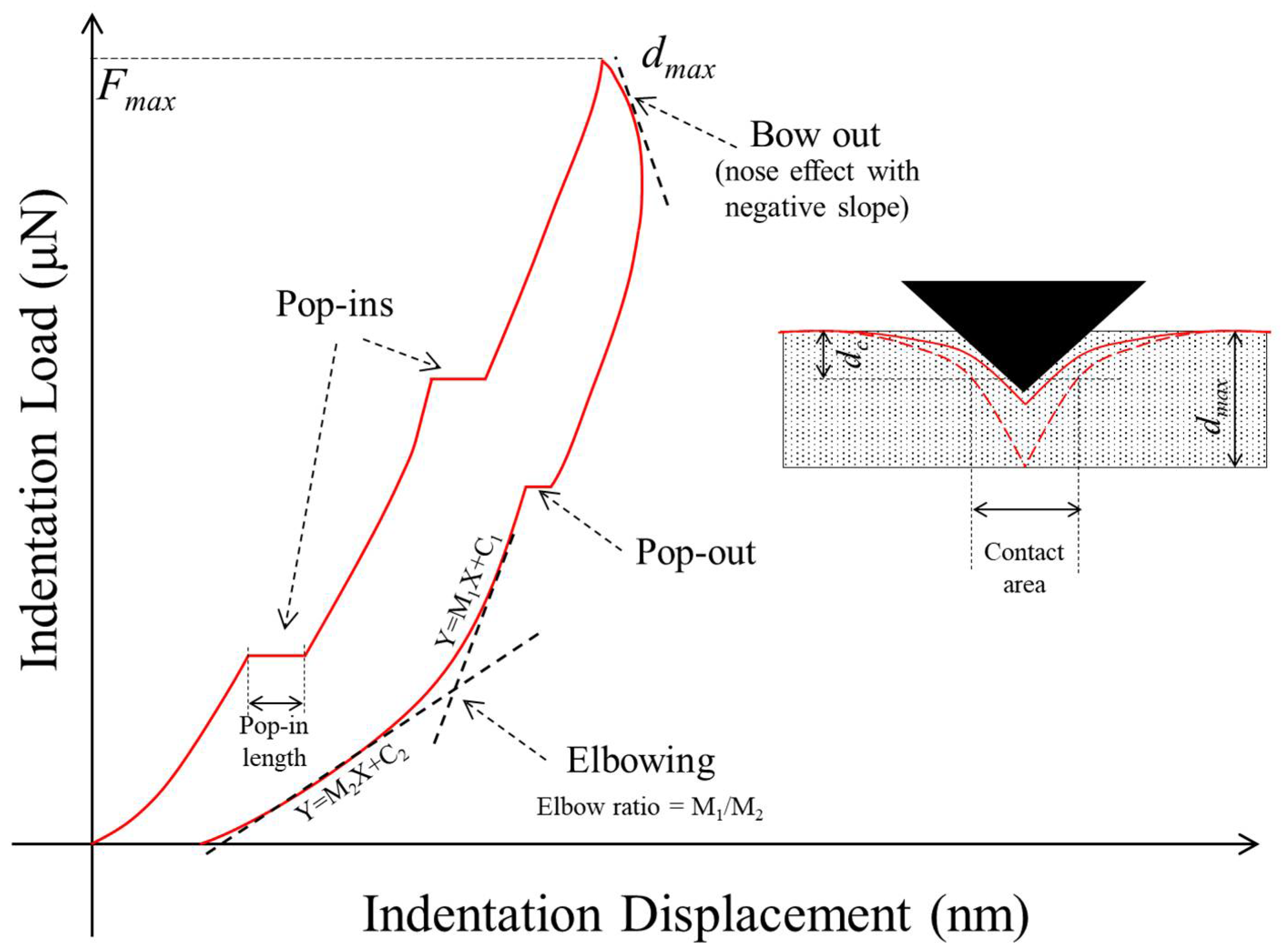
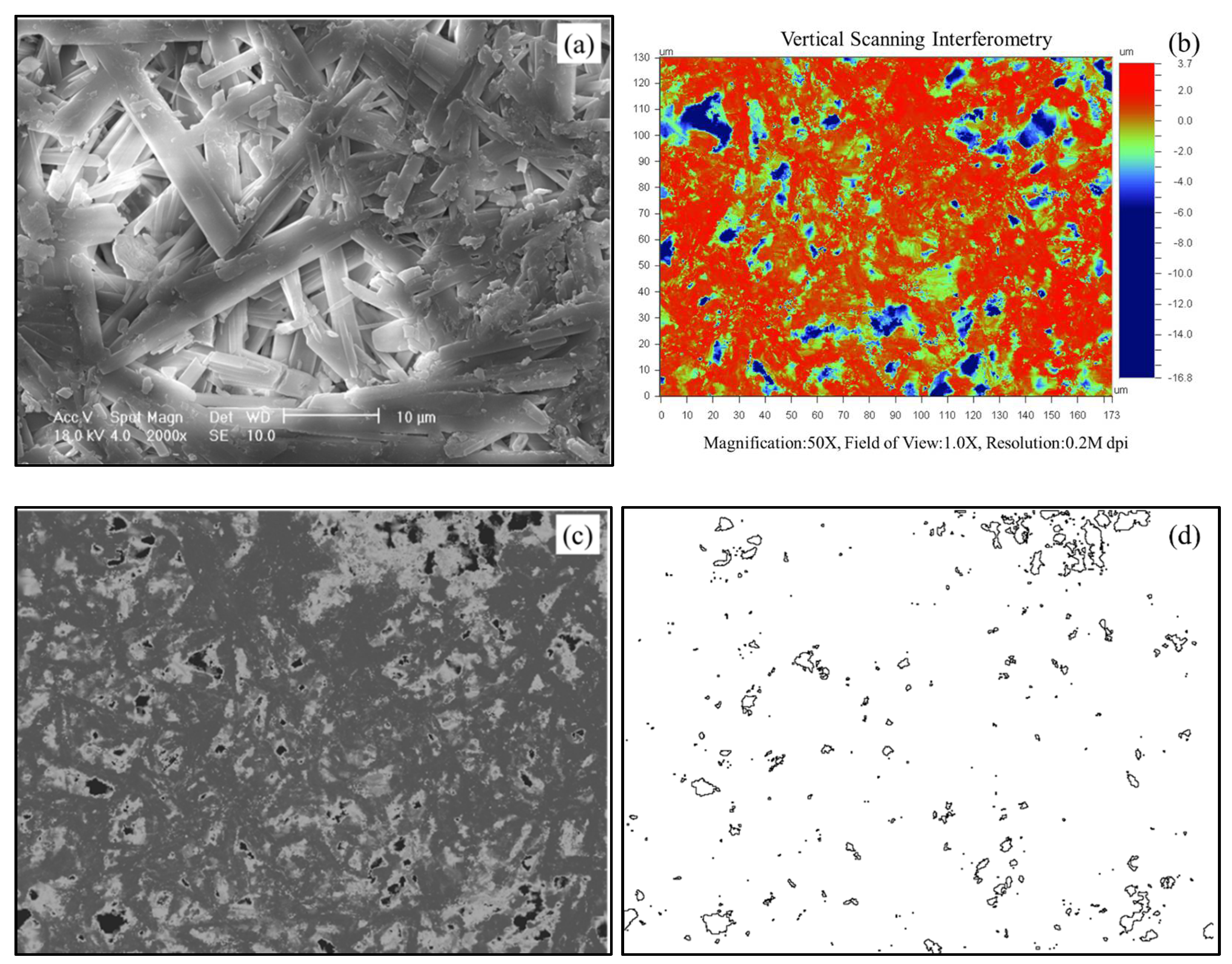
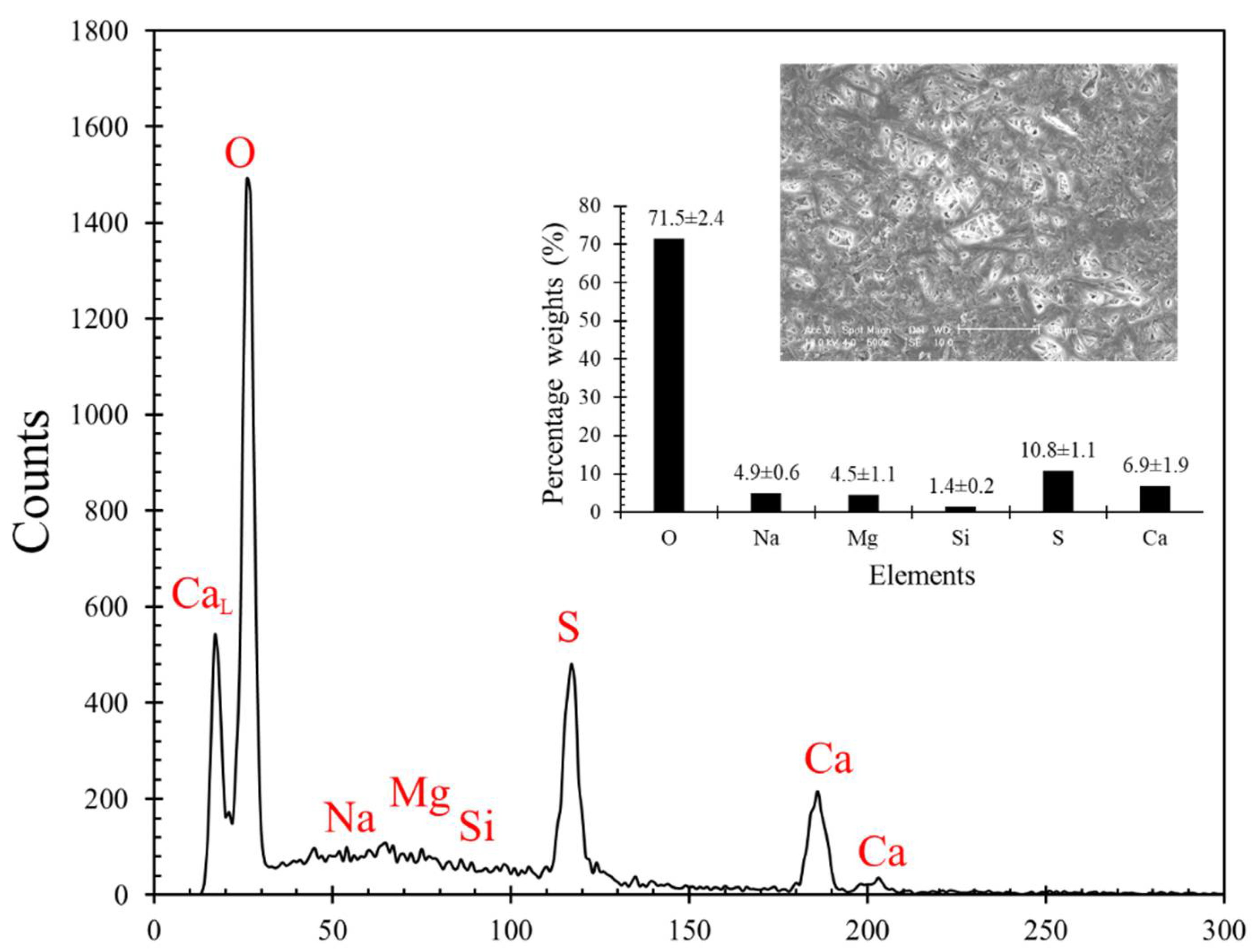
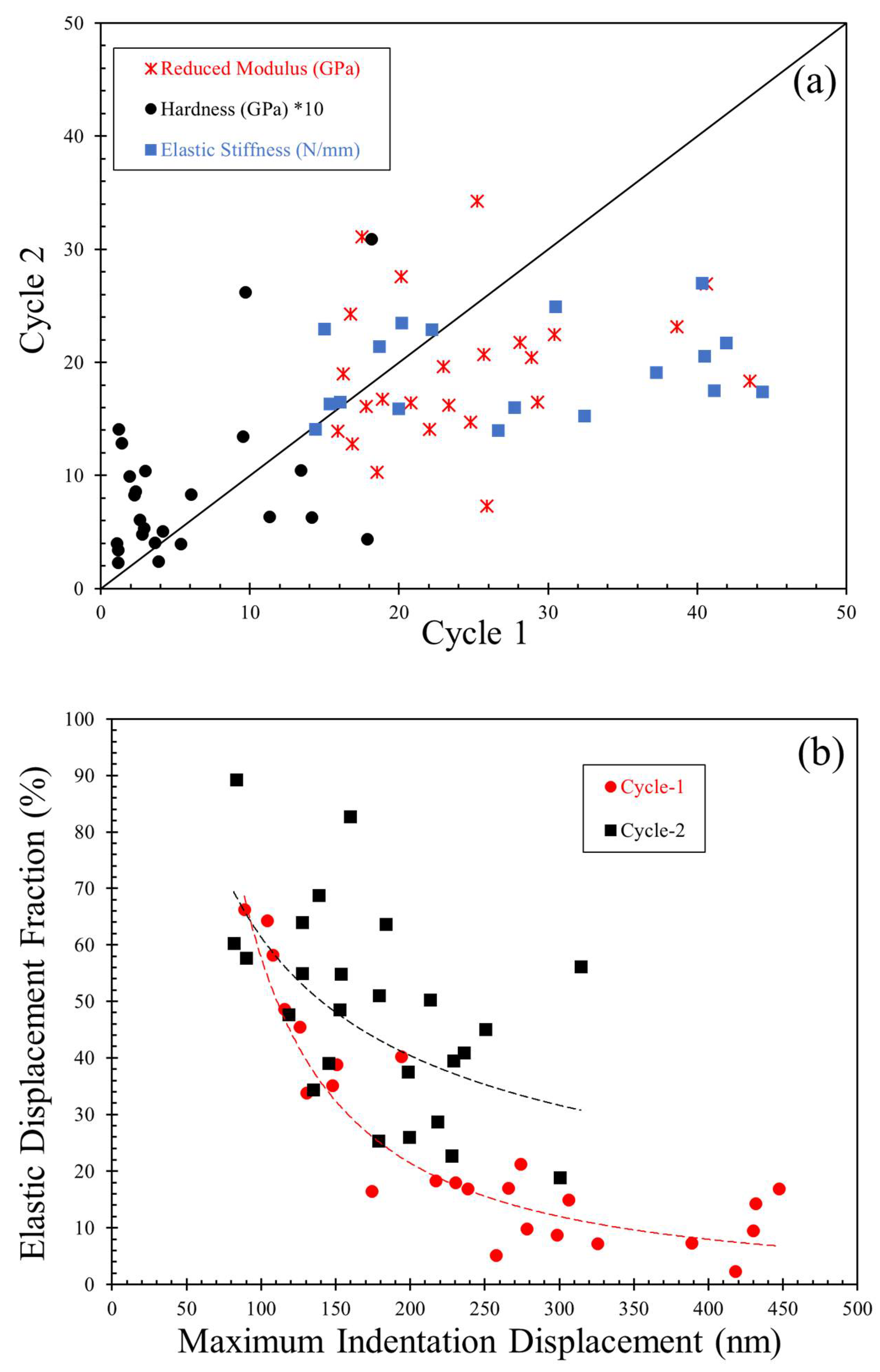

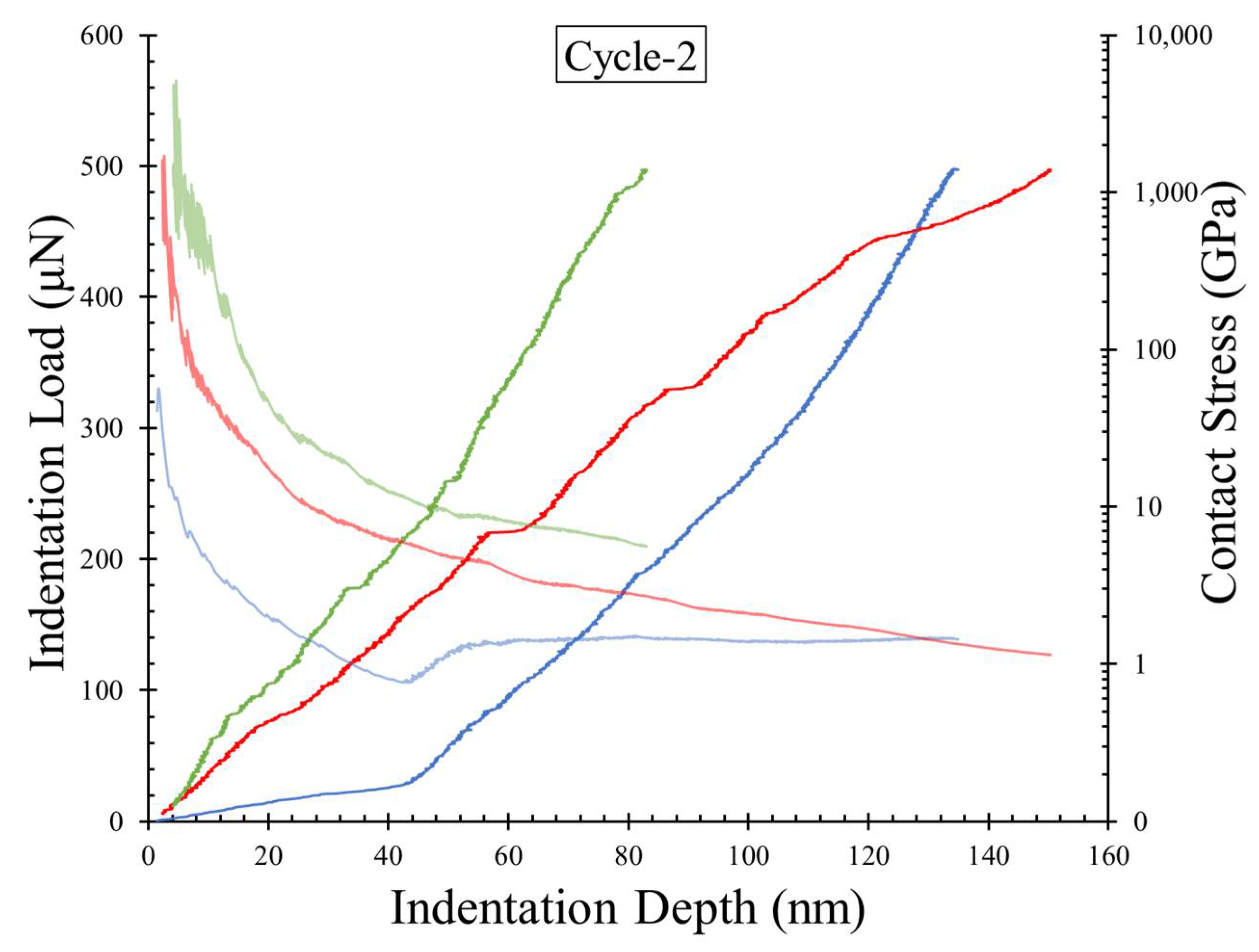
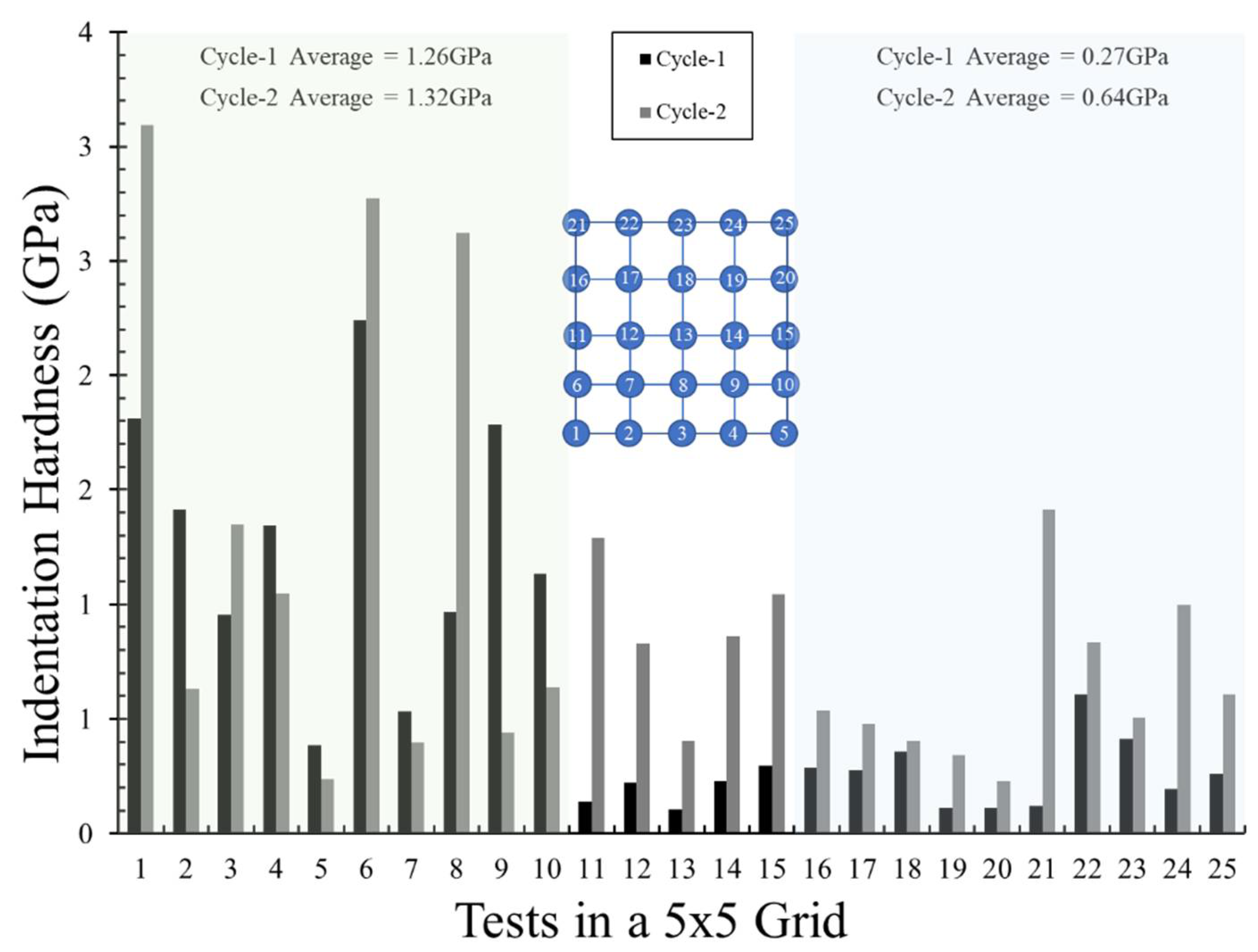

Publisher’s Note: MDPI stays neutral with regard to jurisdictional claims in published maps and institutional affiliations. |
© 2021 by the authors. Licensee MDPI, Basel, Switzerland. This article is an open access article distributed under the terms and conditions of the Creative Commons Attribution (CC BY) license (https://creativecommons.org/licenses/by/4.0/).
Share and Cite
Kasyap, S.S.; Senetakis, K. Application of Nanoindentation in the Characterization of a Porous Material with a Clastic Texture. Materials 2021, 14, 4579. https://doi.org/10.3390/ma14164579
Kasyap SS, Senetakis K. Application of Nanoindentation in the Characterization of a Porous Material with a Clastic Texture. Materials. 2021; 14(16):4579. https://doi.org/10.3390/ma14164579
Chicago/Turabian StyleKasyap, Sathwik S., and Kostas Senetakis. 2021. "Application of Nanoindentation in the Characterization of a Porous Material with a Clastic Texture" Materials 14, no. 16: 4579. https://doi.org/10.3390/ma14164579
APA StyleKasyap, S. S., & Senetakis, K. (2021). Application of Nanoindentation in the Characterization of a Porous Material with a Clastic Texture. Materials, 14(16), 4579. https://doi.org/10.3390/ma14164579






